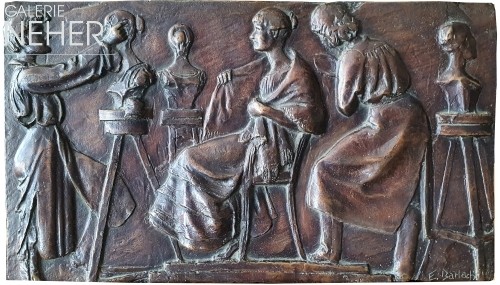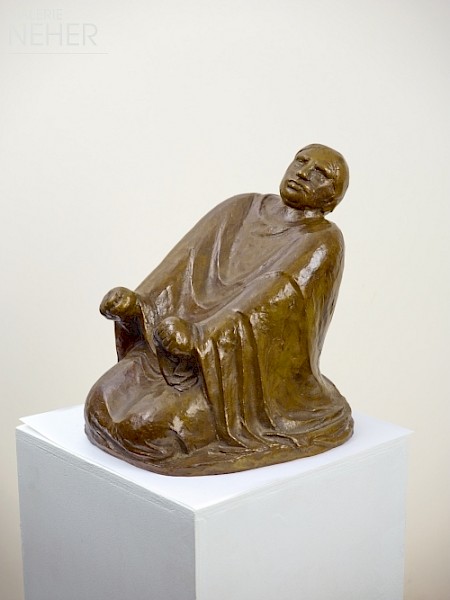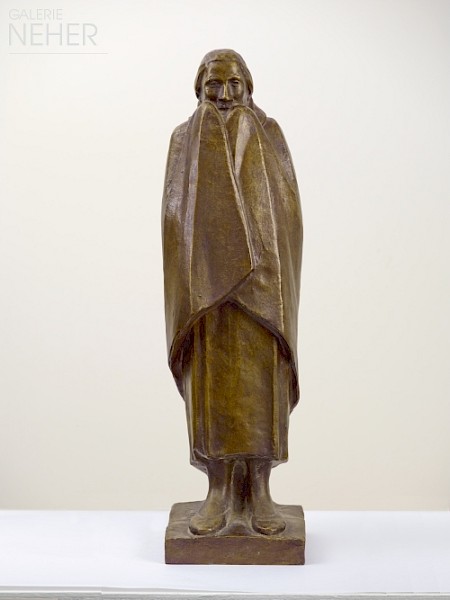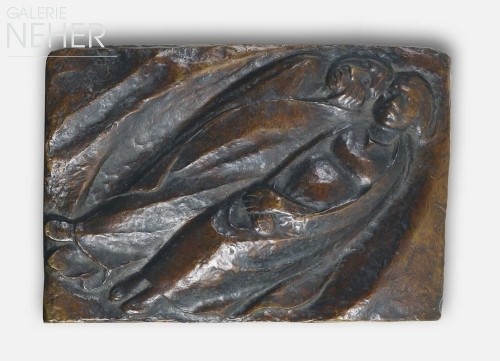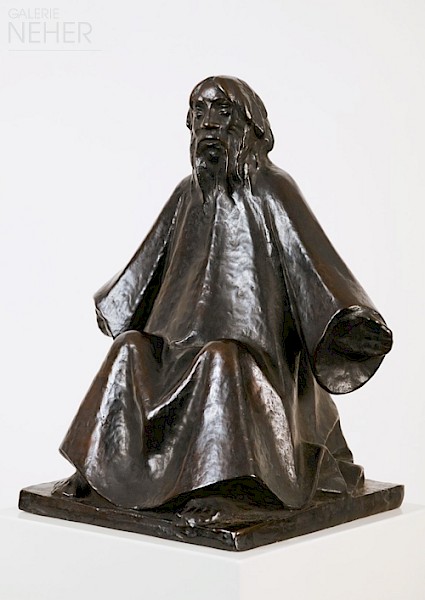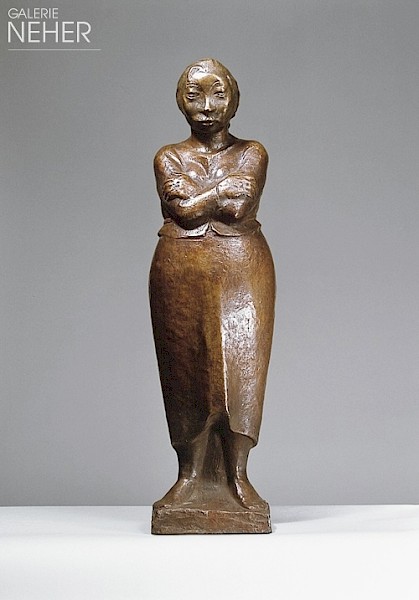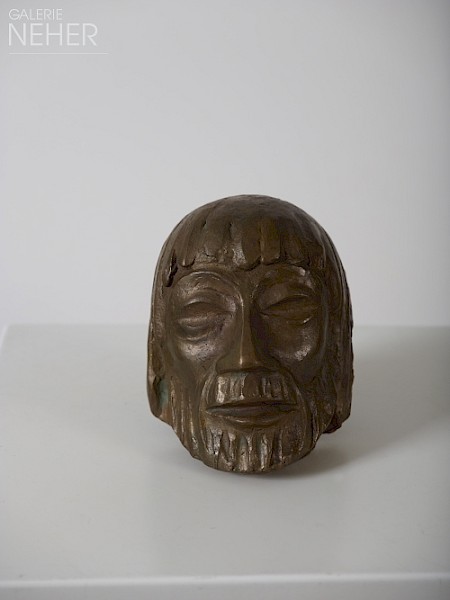Ernst Barlach
* 02 01 1870 | Wedel
† 24 10 1938 | Rostock
Ernst Barlach was a sculptor, graphic artist and author. His sculptural work, located in the field of tension between Realism and Expressionism, is unique and is among the great artistic achievements of the early 20th century. His wooden sculptures and bronze figures assured him a preeminent place in modern art.
Works by Ernst Barlach
Vita Ernst Barlach
1870
Born on 2 January in Wedel on the Lower Elbe.
1888
He begins training at the Allgemeine Gewerbeschule (general vocational school) in Hamburg.
1891
Barlach studies at the Royal Academy of Fine Arts in Dresden.
1892
He becomes a master pupil of the sculptor Robert Diez.
1895
Final examination and first longer study stay in Paris, where he attends the private Académie Julian. He publishes the book Figürliches Zeichnen (Figural Drawing).
1897
Second study stay in Paris.
1898
Workshop cooperative with the sculptor and friend Karl Gabers. Participation in the Great Berlin Art Exhibition and work on figures for the gable relief of the Altona city hall.
1899
Move to Berlin.
1901
Barlach moves back to Wedel, the place of his birth. First attempts to write dramas.
1904
He takes on a teaching position for a half a year at the Technical College for Ceramics in Höhr-Grenzhausen/Westerwald.
1905
Moves again to Berlin.
1906
Trip to Russia, where he creates many sketches. Barlach writes his Russisches Tagebuch (Russian Diary), which appears in 1912 under the title Eine Steppenfahrt (A Journey Through the Steppes), illustrated with 13 lithographs.
Birth of his son Nikolaus from a relationship with his model Rosa Schwab.
1907
Participation in the 13th Exhibition of the Berlin Secession. He publishes drawings in the satirical magazine Simplicissimus.
1908
He is represented at the winter exhibition of the Berlin Secession with seven sculptures and 20 drawings. The Kunsthalle Bremen is the first to acquire one of his works.
Begins working together with the gallery owner Paul Cassirer.
1909
Ten-month study stay in the Villa Romana in Florence, where he meets the poet Theodor Däubler.
1910
Participation in the first exhibition of the Sonderbund Westdeutscher Kunstfreunde und Künstler (Separate League of West German Art Lovers and Artists) in Düsseldorf.
1911
A renovated horse stall in Güstrow serves as his studio.
1912
Participation in the exhibition of the Sonderbund Westdeutscher Kunstfreunde und Künstler (Separate League of West German Art Lovers and Artists) in Cologne. Publication of his drama Der Tote Tag (The Dead Day) with 27 lithographs.
1913
Resignation from the Berlin Secession.
1914
Barlach is elected to the board of the Free Secession. Work on Güstrower Tagebuch (Güstrow Diary).
1915
Volunteers for military service. Becomes a Landsturm (Prussian reserve) soldier in Sonderburg.
1917
Exhibition of his works in the Kunstsalon Paul Cassirer, Berlin.
1919
Barlach becomes a member of the Prussian Academy of Arts. Premiere of his dramas Der arme Vetter (The Poor Cousin) in Hamburg and Der tote Tag in Leipzig.
1920
Publication of the society drama Die echten Sedemunds (The Real Sedemunds).
1922
Dedication of his first cenotaph Die Schmerzensmutter (Our Lady of Sorrows) in the St. Nikolai Church in Kiel. The drama Der Findling (The Foundling) with 20 woodcut prints and the graphic series Die Ausgestoßenen (The Outcasts) appear.
1924
He is awarded the Kleist Prize. His drama Die Sündflut (The Flood) premieres in Stuttgart.
1925
Acquaintanceship with the couple Bernhard and Marga Böhmer, who had settled in Güstrow.
Work on the drama Baal (later Der blaue Boll). He is named an honorary member of the Academy of Fine Arts in Munich.
1926
Romantic relationship with Marga Böhmer, who separated from her husband in 1927.
1927
The Güstrower Ehrenmal (Güstrow Cenotaph) is presented to the public in the Güstrow Cathedral.
1928
Barlach’s autobiography Ein selbsterzähltes Leben (A Self-Told Life) and the drama Der Findling appear. He produces his first graphic self-portraits.
1930
Construction of a new studio house in Güstrow.
His works are exhibited on the occasion of his 60th birthday in the Academy of Arts, Berlin, as well as in Essen, Kiel and Lübeck.
Contract with the art dealer Alfred Flechtheim for the casting of 20 bronzes after plaster models in the Noack foundry in Berlin.
1931
Dedication of the Hamburger Ehrenmal (Hamburg Cenotaph) He is represented with five sculptures in an exhibition of German art in the Museum of Modern Art, New York.
He completes his Lehrenden Christus (Teaching Christ) and various Christusmasken (Christ Masks).
1932
Withdrawal of his designs for a cenotaph in Stralsund.
Special show at the autumn exhibition of the Prussian Academy of Arts in Berlin with sculptural works and drawings.
1933
He protests against the forced expulsion of Käthe Kollwitz and Heinrich Mann from the Prussian Academy of the Arts. Petition of the Magdeburg cathedral congregation council for the removal of his cenotaph from the cathedral.
Exhibition in the Kunsthalle Bern.
1934
Design of a sepulchral monument for his friend Theodor Däubler, which is, however, rejected by the Reich Chamber of Literature; the Magdeburger Ehrenmal (Magdeburg Cenotaph) is dismantled.
Hermann F. Reemtsma commissions Barlach to complete the Fries der Lauschenden (The Frieze of Listeners).
1935
His piece Die echten Sedemunds is cancelled after only five performances at the Altonaer Stadttheater at the instigation of the National Socialists.
He completes the Fries der Lauschenden.
1936
Works by Barlach, Käthe Kollwitz and Wilhelm Lehmbruck are removed from the anniversary exhibition of the Prussian Academy of Arts.
1937
The Güstrower Ehrenmal and the Geistkämpfer (Fighter of the Spirit) are dismantled in Kiel, far more than 300 of his works are removed from German museums and his works are vilified in the National Socialist Entartete Kunst (Degenerate Art) exhibition.
Forced resignation from the Prussian Academy of Arts, and he is subject to a temporary exhibition prohibition.
Exhibition of his works in the Westermann-Gallery, New York.
1938
Removal of the Hamburger Ehrenmal
Barlach dies on 24 October.
